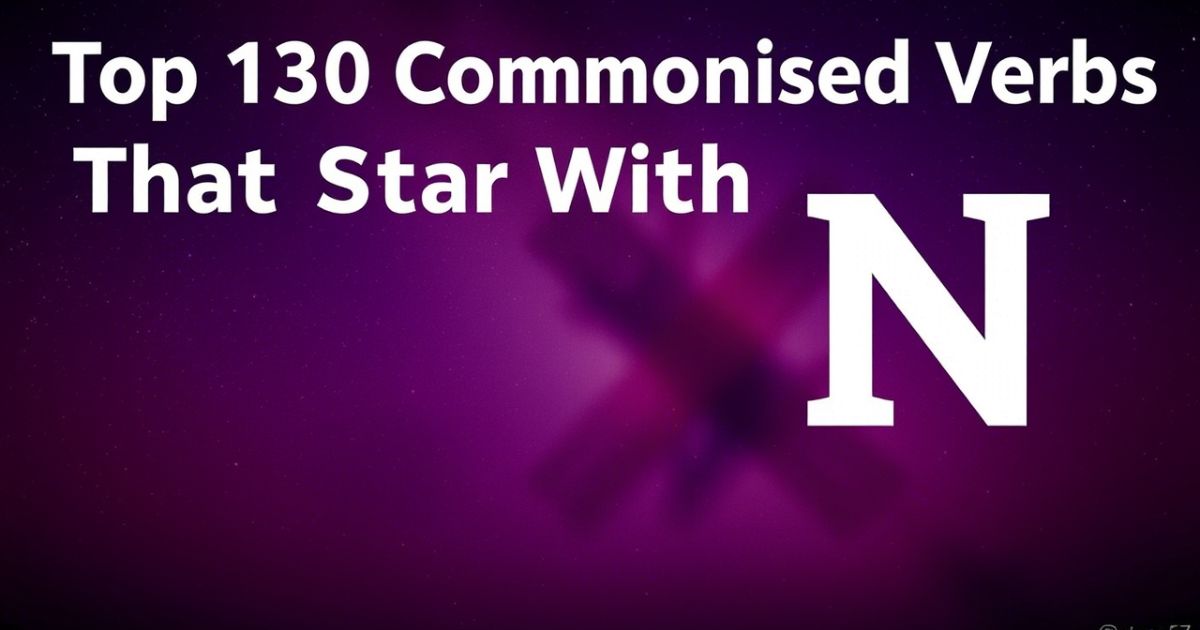Verbs That Start With N are an interesting group of words. These verbs that start with n help describe different actions and activities. There are many n verbs you can use in everyday conversations. Some of these verbs starting with n include words like “nourish,” “navigate,” and “nod.”
When looking for actions that start with n, you can find various options to express different ideas. From “nip” to “negotiate,” these verbs that start with n bring more variety to your speech. Whether you want to navigate a tough situation or simply nurture your plants, these verbs starting with n are helpful. So next time, try using a verb that starts with n to make your sentences more lively and clear.
Movement and Human Action
Movement is fundamental to human life, allowing us to interact with our environment. Actions such as walking, running, or dancing help us express ourselves and engage in various activities. The Verbs That Start With N ability to move efficiently and effectively is crucial in both everyday life and sports.
- Walking: The basic form of movement, allowing humans to travel from one place to another.
- Running: A faster form of movement, typically used for physical exercise or urgency.
- Jumping: An action involving the propulsion of the body off the ground, used for sports or overcoming obstacles.
- Dancing: A rhythmic movement of the body, often in response to music or for artistic expression.
- Swimming: Movement in water, involving various strokes for exercise or recreation.
- Lifting: The act of raising something, requiring strength and control.
- Stretching: Extending the body to improve flexibility and reduce muscle tension.
- Reaching: Extending the arms to touch or grab something, involving coordination.
- Bending: Flexing the body at the joints, often for tasks like picking something up.
- Crawling: A low-to-ground form of movement, often seen in infants or during specific tasks.
- Kicking: A forceful movement of the legs to strike or propel something.
- Climbing: The action of ascending, often requiring strength and balance.
- Crawling: A form of movement where one uses the arms and legs while on the ground.
- Grasping: Taking hold of something with the hands, requiring control.
- Twisting: Rotating the body or limbs, often in a twisting or turning motion.
- Sliding: Moving smoothly across a surface with minimal resistance.
- Hopping: Jumping on one foot or both, often seen in playful or sports-related actions.
- Squeezing: Applying pressure with the hands, often to compress or hold something.
- Crouching: Bending the knees to lower the body closer to the ground, often used in sports or for tasks.
- Lunging: A sudden, forward movement of the body, typically for exercise or sports.
Communication and Expression

Communication and expression are essential for human connection. Humans convey emotions, thoughts, and ideas through speech, gestures, and body language. Verbal communication, like speaking and writing, Verbs That Start With N allows us to share detailed information, while non-verbal forms, such as facial expressions and body movements, help us express feelings that words cannot capture.
- Speaking: The vocal expression of thoughts or feelings, used in everyday conversation.
- Writing: The act of putting thoughts into written words for communication or expression.
- Gesturing: Using hand or body movements to express meaning or emphasize speech.
- Sign Language: A visual form of communication used by those who are deaf or hard of hearing.
- Body Language: Non-verbal communication through posture, movements, and facial expressions.
- Facial Expressions: Conveying emotions or reactions through movements of the face.
- Listening: Actively receiving and understanding spoken or non-verbal communication.
- Reading: Interpreting written symbols or text to gain meaning or understanding.
- Laughing: An expressive vocalization of joy or amusement, often as a response to humor.
- Crying: The expression of sadness or pain through tears, signaling emotional distress.
- Eye Contact: Using the eyes to convey attention, interest, or emotions in communication.
- Shouting: Speaking loudly, often to be heard or express urgency or anger.
- Whispering: Speaking softly, often for confidentiality or intimacy.
- Nodding: A movement of the head, typically indicating agreement or understanding.
- Smiling: A facial expression that typically signals happiness or friendliness.
- Frowning: A facial expression of displeasure or concern.
- Waving: A hand gesture used to greet, signal, or acknowledge someone.
- Sighing: A deep exhalation often indicating frustration, relief, or weariness.
- Nurturing: Caring for and encouraging others, both physically and emotionally.
- Clapping: A gesture often used to show approval, appreciation, or celebration.
Mental and Psychological States
Mental and psychological states play a significant role in how we experience the world. Emotions like happiness, sadness, or anxiety shape our interactions with others and influence our decision-making. A Verbs That Start With N positive mental state, like excitement, can energize us, while stress or anxiety may affect our ability to perform tasks. Understanding these states helps us manage our emotions and reactions.
- Happiness: A positive emotional state characterized by feelings of joy or satisfaction.
- Sadness: A negative emotional state, often caused by loss, disappointment, or frustration.
- Anxiety: A feeling of nervousness or unease, often about a future event.
- Stress: A mental state characterized by tension, pressure, or overwork.
- Calmness: A peaceful and composed emotional state, often achieved through relaxation.
- Anger: A strong emotional reaction to perceived injustice or frustration.
- Fear: A psychological response to potential threats or danger.
- Excitement: A heightened state of emotional arousal, often linked to positive events.
- Confusion: A mental state marked by lack of clarity or understanding.
- Gratitude: A positive emotional state of thankfulness and appreciation.
- Depression: A prolonged state of sadness, often with feelings of hopelessness.
- Guilt: A negative emotional response to actions perceived as wrong or harmful.
- Relief: The easing of stress or anxiety, often after a worrying situation resolves.
- Surprise: A sudden emotional reaction to unexpected events.
- Empathy: The ability to understand and share the feelings of others.
- Regret: A negative emotion related to wishing past actions were different.
- Hope: A positive expectation about future outcomes, often tied to goals.
- Loneliness: A psychological state of feeling disconnected or isolated from others.
- Jealousy: A feeling of insecurity or envy towards others’ success or possessions.
- Reluctance: A mental hesitation or unwillingness to take action or make a decision.
Control and Management
Control and management are crucial in everyday life, whether in the workplace or at home. Effective management involves planning, organizing, and overseeing tasks to ensure that goals are met. Leaders often delegate tasks to others, helping them share responsibilities and avoid overload. Coordination between team members Verbs That Start With N ensures smooth operations, while negotiating and resolving conflicts are essential for maintaining harmony.
- Leading: The act of guiding or influencing others towards a goal or decision.
- Organizing: The process of arranging resources or tasks in an efficient way.
- Delegating: Assigning tasks to others for more effective management.
- Planning: The act of making decisions about the future, setting goals, and determining actions.
- Supervising: Overseeing the work or activities of others to ensure they meet standards.
- Coordinating: Ensuring that different elements work together smoothly and efficiently.
- Negotiating: Reaching agreements between two or more parties with differing views.
- Controlling: Managing or regulating the actions, behaviors, or processes within a system.
- Directing: Giving instructions or orders to manage a situation or group.
- Motivating: Encouraging others to take action or achieve goals.
- Advising: Offering guidance or counsel to help others make decisions.
- Monitoring: Observing and checking progress or performance regularly.
- Evaluating: Assessing performance or results to determine effectiveness or efficiency.
- Improvising: Making quick decisions and adjustments in response to unexpected changes.
- Resolving: Settling disputes or problems through discussion or decision-making.
- Managing: Overseeing resources, people, or processes to achieve objectives.
- Mentoring: Guiding and supporting others’ personal or professional development.
- Implementing: Putting plans or decisions into action to achieve goals.
- Budgeting: Managing financial resources by planning and tracking expenses.
- Troubleshooting: Identifying and solving problems quickly, often in technical contexts.
Creation and Change
Creation and change are at the heart of progress. They drive innovation and transformation, whether in art, technology, or society. People create new ideas, products, or systems to improve life or solve problems. Change, whether small or large, is often necessary to adapt to new conditions. The Verbs That Start With N process of creation starts with an idea and evolves as it takes shape. Change can bring challenges but also opens the door to new possibilities.
- Innovation: Developing new ideas and concepts to improve existing systems.
- Transformation: A thorough or dramatic change in form, appearance, or structure.
- Invention: Creating something entirely new, often to solve a problem.
- Adaptation: Adjusting to new conditions or environments.
- Evolution: The gradual development of something over time.
- Design: Planning and creating something with a specific purpose in mind.
- Development: The process of creating or improving something over time.
- Revolution: A dramatic and wide-reaching change in society or technology.
- Progress: Movement forward towards improvement or advancement.
- Creativity: Using imagination to come up with new ideas.
- Growth: The process of increasing in size, quantity, or importance.
- Breakthrough: A sudden, significant improvement or discovery.
- Renewal: The process of making something new again or refreshing it.
- Modification: Making changes to improve or alter something.
- Disruption: A significant change that shakes up industries or processes.
- Reinvention: Completely changing the nature of something.
- Reformation: The action or process of improving or changing an existing system.
- Innovation cycle: The process of introducing new ideas or products and improving them.
- Creation process: The steps involved in making something new.
- Change management: The process of handling and adapting to changes in an organization.
Related Guide:
Top 200 Commonly Used Verbs That Start With B [2025]
Observation and Cognition
Observation and cognition are essential for understanding the world around us. Observation involves gathering information through our senses, while cognition refers to how we process and interpret that information. People observe their environment to learn, solve problems, and make decisions. Cognitive processes like memory, attention, and reasoning help us make sense of what we observe.
- Attention: Focusing mental resources on specific stimuli or tasks.
- Perception: Interpreting sensory information to understand the world.
- Memory: Storing and recalling information for later use.
- Awareness: Being conscious of and paying attention to the environment.
- Insight: The ability to understand complex situations or ideas clearly.
- Focus: Concentrating mental energy on a particular task or object.
- Reasoning: The process of thinking about things in a logical way.
- Learning: Acquiring new knowledge or skills.
- Judgment: Forming opinions or making decisions based on observations.
- Interpretation: Understanding and explaining the meaning of information.
- Comprehension: Grasping the meaning or significance of something.
- Analysis: Breaking down information to understand it better.
- Recognition: Identifying something based on prior knowledge.
- Reflection: Thinking carefully about something to gain deeper understanding.
- Problem-solving: Finding solutions to complex or difficult situations.
- Cognitive bias: Systematic errors in thinking that affect decisions and judgment.
- Deduction: Drawing specific conclusions from general information.
- Induction: Making generalizations based on specific observations.
- Visual processing: Interpreting information from visual stimuli.
- Sensory processing: The brain’s ability to process and interpret sensory information.
Problem Solving and Making Choices
Problem-solving and making choices are fundamental to daily life. When faced with challenges, people analyze the situation, explore potential solutions, and choose the best course of action. The Verbs That Start With N process often involves identifying the problem, brainstorming solutions, and evaluating possible outcomes. Critical thinking and decision-making skills help individuals navigate complex situations.
- Decision-making: Choosing the best course of action from available options.
- Strategy: Planning a method to solve a problem or achieve a goal.
- Analysis: Breaking down a problem to understand its components.
- Evaluation: Assessing potential solutions to determine the best one.
- Reasoning: Using logic to make decisions or solve problems.
- Judgment: Making decisions based on available information.
- Creativity: Generating innovative solutions to problems.
- Problem identification: Recognizing and defining a problem.
- Risk assessment: Evaluating potential risks involved in a decision.
- Goal setting: Defining clear objectives to guide decision-making.
- Intuition: Making decisions based on instincts or gut feelings.
- Trial and error: Trying different solutions until the best one is found.
- Prioritization: Ranking problems or tasks based on importance.
- Consequence analysis: Considering the outcomes of various choices.
- Reflection: Reviewing past decisions to learn and improve.
- Brainstorming: Generating a wide range of ideas for solutions.
- Planning: Organizing steps to solve a problem or achieve a goal.
- Problem-solving techniques: Specific methods used to approach problems.
- Resource allocation: Distributing resources effectively to solve a problem.
- Decision tree: A visual representation of possible decisions and outcomes.
Various Actions

Various Verbs That Start With N actions encompass the wide range of physical, mental, and social behaviors people engage in daily. These actions can be deliberate or automatic, planned or spontaneous. They are the building blocks of how we interact with the world and others.
- Walking: Moving by foot to travel from one place to another.
- Running: Moving swiftly on foot, typically for exercise or in competition.
- Talking: Engaging in verbal communication with others.
- Writing: Putting thoughts into written form for communication.
- Reading: Interpreting written words for understanding.
- Cooking: Preparing food for consumption.
- Cleaning: Tidying up a space to maintain order and hygiene.
- Driving: Operating a vehicle to travel.
- Shopping: Buying goods or services from stores or online.
- Listening: Paying attention to sounds or conversations.
- Watching: Observing something for information or entertainment.
- Exercising: Engaging in physical activity for fitness or health.
- Sleeping: Resting the body and mind to rejuvenate energy.
- Thinking: Processing information in the brain to solve problems.
- Meditating: Practicing mindfulness for relaxation and clarity.
- Socializing: Engaging with others for companionship or networking.
- Working: Performing tasks or duties for a job or goal.
- Learning: Acquiring knowledge or skills.
- Planning: Organizing steps to achieve a goal.
- Celebrating: Participating in a social event to honor an achievement or occasion.
Cultural and Social Actions
Cultural and social actions are the behaviors that shape and define societies. They include practices, traditions, and rituals that people follow in their communities. These actions help maintain social harmony, pass on values, and create a sense of identity. Cultural actions might involve religious ceremonies, celebrations, or festivals, while social actions often focus on interaction and cooperation with others.
- Tradition: A belief or behavior passed down through generations.
- Celebration: A joyful gathering to honor an event or person.
- Ritual: A set of actions performed according to a cultural or religious practice.
- Greeting: A social action to acknowledge someone’s presence.
- Festival: A communal celebration, often based on culture or religion.
- Community: A group of people living in a specific area or sharing interests.
- Cooperation: Working together for a common goal or benefit.
- Socialization: Interacting with others to build relationships and networks.
- Respect: Acknowledging and valuing the rights and feelings of others.
- Customs: Regular practices that reflect cultural values.
- Networking: Building relationships for social or professional purposes.
- Generosity: The act of giving without expecting anything in return.
- Tolerance: Accepting and respecting differences in others.
- Empathy: Understanding and sharing the feelings of others.
- Solidarity: Unity or agreement of feeling or action.
- Sharing: Distributing something with others to foster community.
- Philanthropy: Charitable acts or donations for the welfare of others.
- Cooperation: The act of working together harmoniously.
- Mentorship: Guiding and supporting others in their personal or professional growth.
- Integration: The process of combining different cultures or groups into one.
Economic and Business Actions

Economic and business actions are behaviors that drive the creation of wealth and the functioning of economies. These actions include making financial decisions, creating products, and providing services Verbs That Start With N. Businesses engage in activities like investing, marketing, and selling, which contribute to economic growth. Economic actions also involve managing resources efficiently to maximize profits.
- Investment: Allocating resources to generate future returns.
- Marketing: Promoting products or services to reach consumers.
- Sales: Selling goods or services in exchange for money.
- Negotiation: Discussing terms to reach a mutually beneficial agreement.
- Budgeting: Planning how to allocate financial resources.
- Trading: Exchanging goods or services for money or other goods.
- Management: Organizing and overseeing business operations.
- Production: Creating goods or services to meet market demands.
- Advertising: Publicly promoting a product or service to attract customers.
- Consumer behavior: Studying how people make purchasing decisions.
- Entrepreneurship: Starting and managing a business venture.
- Outsourcing: Contracting work or services to external organizations.
- Risk assessment: Evaluating potential risks to make informed business decisions.
- Financing: Securing capital to fund business activities.
- Strategy: Planning for long-term business goals and objectives.
- Accounting: Tracking and managing financial transactions in a business.
- Innovation: Developing new products, services, or processes to stay competitive.
- Profit maximization: Increasing revenue while reducing costs to boost profits.
- Supply chain management: Coordinating production, storage, and distribution of goods.
- Economic forecasting: Predicting future market conditions to make informed decisions.
FAQ’s
What are verbs that start with n?
Verb that start with n include words like nourish, navigate, and nod. These n verbs express various actions in both written and spoken language.
Why are verbs starting with n useful?
Using Verbs That Start With N adds variety to your speech and writing. They help express different actions, making your language more engaging and dynamic.
Can you give examples of verbs that start with n?
Some common verb that start with n are negotiate, nurture, nap, and nod. These n verbs are simple but powerful for communication.
How do actions that start with n improve sentences?
Actions that start with n enhance sentences by adding clarity and detail. Using verbs that start with n helps you convey thoughts in a more precise way.
Are verbs that start with n easy to use?
Yes, verb that start with n are easy to use. N verbs like nurture, name, and nap can fit easily into everyday conversations.
Conclusion
verbs that start with n are an essential part of the English language. Using these n verbs can make your sentences more interesting and expressive. Words like “navigate,” “nurture,” and “negotiate” are common examples of verbs starting with n that can be used in different situations.
By adding these verbs that start with n to your vocabulary, you can improve your writing and speaking. Whether you’re talking about everyday actions or expressing more complex ideas, verbs starting with n provide more options. So, next time you need to describe an action, try using a verb that starts with n. It will make your language more vivid and clear. These n verbs are easy to use and can make your communication more effective.

Zion Blaze is a dedicated administrator with 5 years of experience in managing operations, optimizing workflows, and ensuring efficiency. Skilled in leadership, problem-solving, and team coordination.

